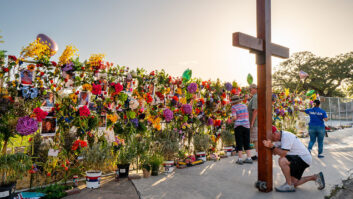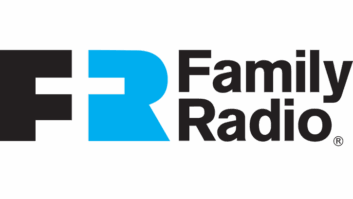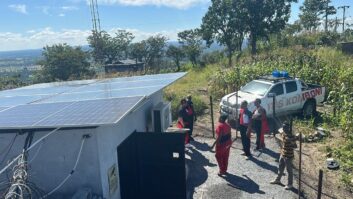
Author’s vintage Ray-Jefferson Model 630 Radio Direction Finding receiver. In the days prior to GPS, mariners used Radio Direction Finding receivers as navigational aids.
RDF radios basically are specialty radio receivers for longwave frequency reception, ranging from 150 kHz to 520 kHz and outfitted with rudimentary direction finders. The 150–520 kHz portion of the spectrum at one time was populated with many marine beacons, all transmitting their call signs continuously in slow CW for identification and location. Some even transmitted weather reports using AM voice. A very large rotatable ferrite antenna atop the RDF receiver, a compass reference and signal strength meter were used to hone in on a particular marine radio beacon.
RDFs were produced for many decades by manufacturers such as Gladding, Ray Jefferson, Raytheon, Pearce-Simpson, and even Heathkit and Hammarlund, names familiar to SWLS and hams. Most were portable, powered by batteries, and had built-in telescopic antennas for other bands that were included such as the old Marine band (2–4 MHz coverage), or perhaps the “new” VHF marine band (156.05–162.025 MHz), FM BCB (88–108 MHz), and even the CB band. Most models included the AM broadcast band, which probably served as the ship’s main source of entertainment in former days.
RDFs can be used by longwave enthusiasts or even AM DXers as auxiliary receivers because of their ability to null out unwanted AM signals on the broadcast band via the large rotatable ferrite antenna.
My shack is graced with the presence of a beautiful example of an RDF manufactured around the 1970s: the Ray Jefferson Model 630, produced by Jetronic Industries of Philadelphia. It runs off eight D cells or a ship’s 12V battery. It’s an excellent performer on AM, not only because of its ability to bring in weak stations, but also because it can null out man-made noise which constantly plagues the AM band.


Side view of Ray-Jefferson RDF with large rotatable ferrite antenna for aiming at beacons.Top view showing 360 degree azimuth dial and rotatable ferrite antenna. This five-band radio includes AM/FM/ CB/LW/VHF and is a reflection of the era in which it was produced due to the fact that the CB and VHF bands are included. CB, very popular in the 1970s, was embraced by those on board ships because it was a cheap and additional way of communicating with other operators both on land and sea. In addition, a license was not needed for CB, and the Coast Guard and local police would monitor emergency CB Channel 9, an additional safety net for the mariner. The VHF band, on the other hand, came in handy for listening to NOAA weather stations from 162.400–162.550 MHz or for other public service activities.
RDF radios are now mainly relegated to history, as are most of the maritime beacons, but those who are interested in a receiver for distant AM BCB reception, aeronautical longwave beacon reception, or perhaps limited shortwave reception, then you might want to pursue this fun avenue of listening.


This model included AM, FM, CB, longwave and VHF bands.Controls layout from the Ray-Jefferson instruction handbook, circa 1970. These radios can be found at ham fests, flea markets or my favorite, eBay. If you search under “RDF” you’ll always find at least a few up for auction, and if you check “completed auctions” in the eBay menu, you’ll be amazed at the many different makes, models, and features of these radios in their half-century history. As mentioned earlier, older models included 2–4 MHz AM reception, which includes the 120 and 90m tropical bands, so those shortwave listeners interested can “hone in” (pun intended) on those particular models.
Mario Filippi is a freelance writer, long time radio amateur (N2HUN) and an avid short wave, longwave, VHF/UHF and satellite enthusiast.







